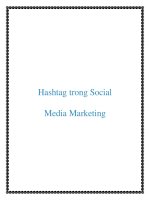Getting more Budget for Social Media
Bạn đang xem bản rút gọn của tài liệu. Xem và tải ngay bản đầy đủ của tài liệu tại đây (73.22 KB, 4 trang )
socialmediatoday.com
/>utm_source=feedburner&utm_medium=email&utm_campaign=Social+Media+Today+(all+posts)
Getting more Budget for Social Media
Posted by:Adriel Michaud
Please login or register to follow this user.
Like it?
Posted November 13, 2012
You've done it. You've managed to convince management to give you some budget to apply to
social media. You've built out a plan and have been executing, but you're running across some
challenges of the fiscal nature.
Management won't ok the spend for your engagement platform or additional people or other
resources. It seems as if the well has dried out for additional funding for your initiatives. In this
article, I'll go over common objections and solutions for getting more budget freed up and applied
to your social media campaigns.
What does social media do for your organization? This is a fair question for management or the
powers that be to ask. It's supposed to do something, right? What's that something, and how
does it relate to the business?
One of the big problems with most social media experts is how they communicate with "suits" on
what they're doing and what kind of impact they're having. One of the hottest arguments is on this
whole "ROI" discussion, and it's really a reflection of a failing of social media practitioners to speak
suit language.
If you throw too many non-business relative metrics at a suit, they'll get frustrated and throw out
ROI as an example of a business relative measure that they're familiar with. If you get stuck in an
ROI argument with your upper management, it's because you failed to deliver them a
measurement that matters.
So what matters? Businesses invest money for any combination of 3 desired results:
Increase revenue
Decrease costs
Increase customer satisfaction
You can appeal to upper management's early adopter side to hook them initially, but you'll need to
show impact on one or more of the above in order to sustain or increase a real meaty budget.
Hope only goes so far before you gotta show them the money; money you help earn, money you
help save, and customers that are more satisfied. You can show these results on a short time
scale or a long one, but you have to link them somehow. Slam dunk social media stats look like
this:
Social media was utilized to introduce us to 3 eventual hires this year. Had we used a
recruitment agency, this would have cost us $60,000. (Cost savings)
Twitter generated 10 new leads last year, 1 of which closed at $20,000. (Revenue
increasing)
A perfect understanding is not necessary, but if you can provide some stats or proof around how
social media supports important business functions, it can go a long way. For example:
15% of our new customers this year mentioned following our blog. While we can't be sure
to the extent that this influenced the sale, several of them mentioned content from the blog
as primary drivers for contacting us. Tom Selleck of Acme Printing wrote, "Been following
your blog for a while, and you guys seem like the experts in cloud printing solutions. Can you
have one of your salespeople give me a call to discuss your solution?" (Revenue increasing)
After implementing our engagement platform, we were able to engage customers who
were complaining about our service extremely fast. Last year, we had 4 tweets complaining
about our service get over 20 retweets, resulting in poor brand experience. Since
implementing the platform, we've had none. We've also found that supporting a customer
over Twitter averaged only 4 minutes of actual support vs our call center's average of 12
minute service calls, so we're likely reducing call center costs by intercepting customers on
social media. We engaged 296 customers since implementation. (Increasing customer
satisfaction, decreasing costs)
Now that I've painted an ideal picture of tying social media outputs with business-relative goals, I'd
like to outline a few pitfalls that you should avoid:
Impressions are not impressive
Quite frankly, compared to other methods of advertising, your impressions stats are going to suck.
Your tweet potentially went out to 20,000 people, so you want a pat on the back? A billboard on a
popular road could do a half million in a week. Still want to be measured on impressions? Radio,
newspaper, and other channels are going to whip your butt. Impressions by itself is a terrible stat,
because it lacks appropriate context. Great marketing engages the right person at the right time at
the right place. Impressions as a stat doesn't guarantee ANY of those. Could be the wrong person,
could be the wrong time, could be the wrong place. Strive for better than just impressions by
adding context.
What does an impressions stat with context look like? "200 of our identified prospects read our
newsletter and clicked through to a blog post." This kind of statistic still sucks because it doesn't
tie back to real business results, but at least it offers some relevance and a real world SIGNAL in
the click throughs.
Don't F with ROI
Want to be ridiculed behind your back by your MBA overlords? Make up your own acronym for
Return on Investment (ROI). ROI is something very specific and measurable. It means something in
strategy documents and is a universal statistic for pencil pushers to use to speak about the same
thing. If you mess around with what ROI means, you're just like that aunt who makes up her own
shorthand abbreviations. lolthxbnothx (LOL, thanks, but no thanks). You have 2 other avenues
that you can go down if you don't have direct return attributable to what you do. If you don't
directly impact the bottom line, you can show how you save money or increase customer
satisfaction, but for god's sake, don't screw with ROI. Don't make up a stat like Return on
Engagement, Return on Impressions, Return on Relationships, or any others.
Don't make your own goals
If you were to look at your boss' compensation plan, you'd be hard pressed to find him/her being
bonused on "website traffic", "retweets", or Squidoo lenses. They are incentivized to increase
revenue, reduce cost, and increase customer satisfaction and they have a finite amount of
resources to accomplish those goals. Your strategies that you present can be measured by other
means, but you have to eventually tie it back to a measurement that really means something.
Summary
This post was born out of frustration I had from hearing 2 sides of the social media results story
from people who weren't speaking the same language. Social media provides a powerful platform
and new approaches to contacting customers, advocates, and other interesting people, but
without some form of tracking, it can become a bit of a money/time pit. At the same time, I see
great impacts from social media that seem to come out by accident, and then the strategy isn't
changed to match observed results. If you thought your social media was going to get you leads,
but then it turns out to improve customer retention, you need to re-evaluate impact and spend
accordingly. By understanding what impacts you're having for your organization, measuring to the
best of your ability, and communicating those impacts, you'll get the green light from upper
management.
A shameless plug for our blog, here's how to setup goals in Google Analytics (a great part of
tracking social media success): />analytics/
Connect:
Aut hored by:
Adriel Michaud
As Partner and Director of SEO at Top Draw, Adriel Michaud is committed to maximizing ROI
for his clients. He helps companies understand how effective internet marketing can drive
their business forward and set them apart from the competition. His fact-based approach to
web analysis, along with his extensive industry experience, translates into business process
improvement and online success.
See complete profile
Would you like to contribute to this site? Get started »









